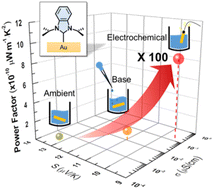Deposition condition impacts charge tunneling and thermoelectric properties of N-heterocyclic carbene monolayers†
Abstract
N-heterocyclic carbene (NHC) is an emerging anchor moiety for surface engineering and various applications. While various deposition conditions have been reported, how these affect the charge transport properties of NHC adsorbates remains uncertain. A NHC salt precursor based on benzo[d]imidazole with a PF6− counterion was deposited onto an ultrasmooth gold substrate using three different conditions for creating NHC monolayers: ambient incubation (AI), base (tert-butoxide)-induced deprotonation (BD), and electrochemical deprotonation (ED). Junction measurements using the EGaIn technique revealed that current density increased by ∼101.7 in the order of AI < BD < ED, while the Seebeck coefficient showed the opposite trend, ranging from 9.3 to 13.5 μV K−1. First-principles calculation reproduced the experimentally observed positive sign of the Seebeck coefficient. Further surface characterizations and computational calculations indicated that the different deposition conditions cause variation in surface coverage in the order of AI < BD < ED. This variation has a significant influence on the broadening of HOMO level and marginal impact on the energy offset between HOMO and Fermi levels, accounting for the opposite trends of electrical conductance and thermopower as a function of the deposition conditions. Finally, we found that the power factor of the NHC monolayer can increase by ∼102 depending on the deposition condition.



 Please wait while we load your content...
Please wait while we load your content...